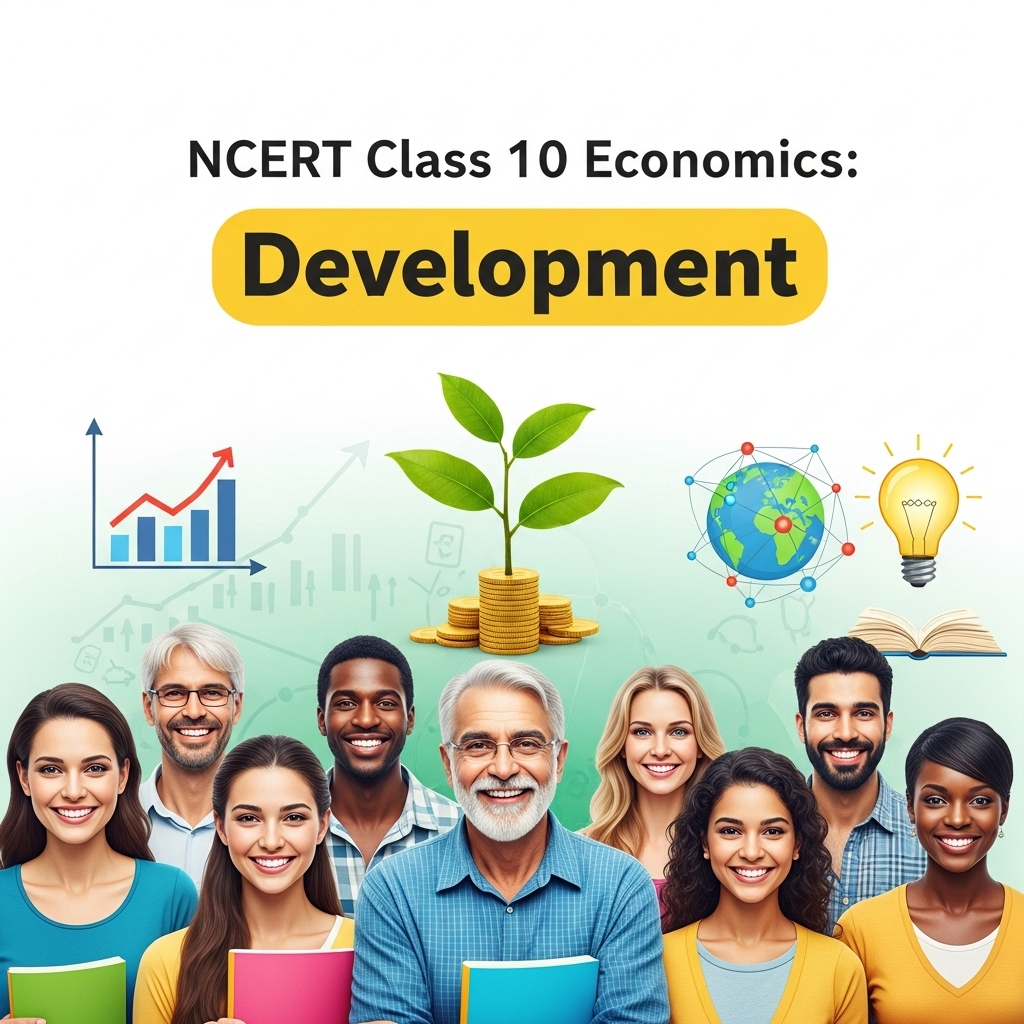Complete Solutions and Summary of Development – NCERT Class 10, Economics, Chapter 1 – Summary, Questions, Answers, Extra Questions
Comprehensive summary and explanation of Chapter 1 'Development', discussing different perspectives on development, common indicators, economic growth vs. quality of life measures, income and its limitations, environmental sustainability, and understanding of key terms like Per Capita Income, Literacy Rate, Life Expectancy, and Human Development Index—with all question answers and extra questions from NCERT Class X Economics.
Updated: 2 months ago
Categories: NCERT, Class X, Economics, Summary, Extra Questions, Development, Economic Indicators, Quality of Life, Environmental Sustainability, Human Development, Chapter 1

Development
Chapter 1: Economics - Complete Study Guide | NCERT Class 10 Notes & Questions 2025
Comprehensive Chapter Summary - Development Class 10 NCERT
Overview
- Chapter Purpose: Introduces development as multifaceted, covering economic, social, and environmental aspects. Aims to help students understand diverse perspectives on progress, common indicators like income, literacy, health, and sustainability. Uses real-life situations for intuitive responses and macro analysis for depth. Key Insight: Development involves aspirations for better life, equality, and sustainability; influenced by history, politics, and economics.
- Structure: Begins with personal/national goals, moves to comparison methods (income, HDI), public facilities, and sustainability. Figures/Tables: Table 1.1 (goals), 1.2 (averages), 1.3/1.4 (states comparison), 1.5 (education), 1.6 (HDI neighbors), 1.7 (crude oil).
- Expanded Relevance 2025: With reprint 2025-26, emphasizes updated data (e.g., 2023 PCI, HDI 2023-24); links to SDGs, climate change impacts on sustainability. Update: Ongoing debates on equitable growth post-COVID.
- Exam Tip: Focus on differences in goals, limitations of averages, HDI components; use tables for comparisons.
- Broader Implications: Promotes debate on fair development paths benefiting majority; integrates economics with history/politics.
What Development Promises – Different People, Different Goals
- Idea of Development: Progress involves aspirations for better living, equality, and collective well-being. Questions: What essentials for better life? How to achieve goals democratically? Cartoon Insight: Highlights unequal opportunities.
- Diverse Aspirations: Table 1.1 lists categories (landless laborers, farmers, women, youth, adivasis) with goals like more work/wages, high income, freedom, education abroad. Students complete/add categories. Key Point: Goals vary by life situations; e.g., rural woman seeks freedom like brother.
- Conflicting Goals: Aspirations may conflict (e.g., girl's freedom vs. brother's sharing housework; dams for industry vs. displacement for tribals). Clear: Different goals; one’s development may harm another's. Example: Sardar Sarovar Dam protest.
Income and Other Goals
- Common Desires: Regular work, better wages, fair prices (more income). But also non-material: equal treatment, freedom, security, respect (e.g., no discrimination).
- Beyond Material Goods: Quality of life depends on non-measurables like friendship. Ignored in income focus. Example: Job choice considers family facilities, security over high pay.
- Mix of Goals: Development = income + dignity, security. E.g., women's paid work boosts dignity but needs respect/sharing for feasibility. Safe environment enables more opportunities.
- National Development: Varies/conflicts; decide fair path benefiting large numbers. Activity: Discuss India's development priorities.
SEO Note: Why This Guide?
Top-ranked for 'Development Class 10 notes 2025'—free, with 60 Q&A from PDF, quizzes. Integrates economic indicators.
How to Compare Different Countries or States?
- Comparison Criteria: Depends on purpose (e.g., height vs. intelligence for students). For countries: Income as key attribute (higher = more developed, assuming access to needs).
- Per Capita Income (PCI): Average income = total income / population. Useful for cross-country comparison. World Bank: High (>US$63,400, 2023), Low (
- Average Income Limitations: Hides disparities (Table 1.2: Country A equitable vs. B unequal, both avg. 10,200 Rs). Key: Distribution matters; equitable better for most.
Income and Other Criteria
- Beyond Income: When looking at goals, consider security, respect, etc. For nations: Health, education indicators.
- State Comparison: Table 1.3: Haryana PCI Rs 2,64,729 > Kerala 2,34,405 > Bihar 47,498 (2021-22). But Table 1.4: Kerala IMR 6/1000 < Haryana 28; Literacy 94% > Haryana 82%; Attendance 94% > Haryana 73%. Insight: Income doesn't buy all (e.g., pollution-free air, unadulterated meds).
- Public Facilities: Cheaper collectively (e.g., community security vs. individual; public schools). Kerala low IMR due to health/education provisions; good PDS improves nutrition. Study: Tamil Nadu 90% rural use ration shops vs. West Bengal 35%.
- Activity 2: Table 1.5 Uttar Pradesh education: Rural literacy 76% male/54% female; Attendance 85%/82%. High child illiteracy disturbing post-independence; constitutional goal free education by 1960 unmet.
Human Development Report
- HDI Overview: UNDP measure: Educational levels, health (life expectancy), PCI. Table 1.6 (2022): Sri Lanka GNI $11,899, LE 76.6, Schooling 11.2, Rank 78; India $6,951, 67.7, 6.5, 134; Bangladesh $6,511, 73.7, 7.4, 129. Notes: PPP for PCI; HDI out of 193 countries.
- Surprises: Sri Lanka ahead of India; Nepal/Bangladesh better LE than India despite lower PCI. Focus: Human well-being over income.
- Activity 3: BMI calculation for nutrition (weight/height²); discuss habits without shaming.
Cases for Exams
Compare Kerala-Haryana; analyze HDI neighbors; discuss groundwater overuse impacts.
Sustainability of Development
- Need for Sustainability: Current development unsustainable (warnings since 20th century). Desirable to maintain/improve for future generations.
- Example 1: Groundwater in India: Overuse in 300 districts (decline >4m/20yrs); 1/3 overusing, 60% in 25yrs if continued. In prosperous Punjab/W UP, hard rock areas, coasts, urban. Questions: Why overuse? Development without?
- Renewable vs. Non-Renewable: Groundwater renewable but overused if extraction > recharge (e.g., rain). Non-renewable: Fixed stock (e.g., crude oil).
- Example 2: Exhaustion of Natural Resources: Table 1.7 Crude Oil Reserves (2017): Middle East 836 thou. Mb, lasts 70 yrs; World 1732, 47 yrs. India imports, price hikes burden; USA secures via power. Questions: Essential for development? India's problems?
- Implications: Global issue; interdisciplinary (scientists, economists). Quote: "Earth enough for needs, not greed." Environmental degradation borderless.
Exercises Summary
- Focus: MCQs, short, long on indicators, comparisons, sustainability. Expanded to 60 Q&A: 20 short (2M), 20 medium (4M), 20 long (8M).
- Project Idea: Invite speakers on regional development; wall chart on agreements/disagreements.
Group Discussions
No forum posts available.


